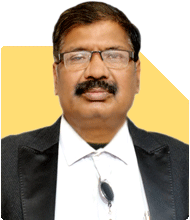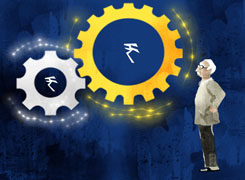Ramalingam Kalirajan |8027 Answers |Ask -Follow
Mutual Funds, Financial Planning Expert - Answered on Jul 01, 2024
He has an MBA in finance from the University of Madras and is a certified financial planner.
He is the director and chief financial planner at Holistic Investment, a Chennai-based firm that offers financial planning and wealth management advice.... more

Good morning sir I am 54 years old I am working in abroad after sometime I am planning to settle in india so please guide me which is the best investment plan to start so for i do not have any investment in mutul fund.
Understanding Mutual Funds
Mutual funds pool money from many investors to invest in various assets like stocks, bonds, and other securities. They offer diversification, which reduces risk.
You get access to professionally managed portfolios. A Certified Financial Planner (CFP) can help you choose funds that match your financial goals and risk tolerance.
Benefits of Mutual Funds
1. Professional Management
Mutual funds are managed by experts who make informed decisions based on market research. This professional management can optimize your returns.
2. Diversification
Mutual funds spread investments across various assets. This reduces risk because not all assets perform poorly at the same time.
3. Liquidity
You can easily buy or sell mutual fund units. This liquidity ensures you can access your money when needed.
4. Flexibility
Mutual funds offer different schemes for different goals. Whether you want growth, income, or preservation of capital, there’s a fund for you.
5. Tax Benefits
Certain mutual funds offer tax benefits under Section 80C of the Income Tax Act. This can help in reducing your taxable income.
Types of Mutual Funds
1. Equity Funds
These invest primarily in stocks. They offer high returns but come with higher risk. Suitable if you have a high-risk tolerance.
2. Debt Funds
These invest in bonds and other debt instruments. They are less risky and provide steady returns. Ideal if you prefer stability.
3. Hybrid Funds
These invest in a mix of equity and debt. They balance risk and return, making them a good choice for moderate risk-takers.
Evaluating Your Risk Tolerance
At 54, your risk tolerance might be lower. It’s important to assess how much risk you’re willing to take. A CFP can help you evaluate this and recommend suitable funds.
1. Conservative Investor
If you prefer low risk, debt funds are a better choice. They provide steady income with lower risk.
2. Balanced Investor
If you can take moderate risk, hybrid funds are ideal. They offer a balance of growth and income.
3. Aggressive Investor
If you have a higher risk tolerance, equity funds can provide substantial growth. However, be prepared for market fluctuations.
Creating a Balanced Portfolio
A balanced portfolio is crucial. It spreads risk and ensures stability. Here’s a simple approach:
1. Core Portfolio
Allocate a significant portion to debt funds for stability and regular income.
2. Growth Portfolio
Invest in equity funds for potential high returns. This portion can grow your wealth over time.
3. Balanced Portfolio
Include hybrid funds to balance risk and return. They provide growth with some level of safety.
Regular Monitoring and Review
Investing in mutual funds is not a one-time activity. Regular monitoring and periodic reviews are essential.
1. Performance Review
Track the performance of your funds regularly. Ensure they are meeting your expectations and financial goals.
2. Rebalancing
Rebalance your portfolio periodically. Adjust the allocation between equity and debt based on market conditions and your goals.
3. Stay Updated
Stay informed about market trends and economic changes. This helps in making informed decisions.
Benefits of Investing Through a CFP
1. Personalized Advice
A CFP provides tailored advice based on your financial situation and goals. They help in choosing the right funds and strategies.
2. Ongoing Support
A CFP offers continuous support and advice. They help in monitoring your portfolio and making necessary adjustments.
3. Peace of Mind
With a CFP, you can be assured that your investments are in expert hands. This gives you peace of mind and reduces stress.
Disadvantages of Index Funds and Direct Funds
1. Index Funds
Index funds replicate the performance of a market index. They offer lower returns compared to actively managed funds. They lack flexibility in managing market changes.
2. Direct Funds
Direct funds bypass intermediaries, but lack professional guidance. Without expert advice, you might miss out on optimal investment strategies.
Actively Managed Funds Through MFD with CFP
Actively managed funds aim to outperform the market. Fund managers make strategic decisions to maximize returns. Investing through an MFD with CFP credentials ensures you get professional advice and support.
Building a Retirement Corpus
At 54, building a retirement corpus is crucial. Mutual funds can help you achieve this. Here’s a simple approach:
1. Define Your Goals
Determine how much you need for retirement. Consider your lifestyle, healthcare, and other expenses.
2. Choose the Right Funds
Based on your risk tolerance, choose a mix of equity, debt, and hybrid funds. A CFP can help in selecting the right ones.
3. Systematic Investment Plan (SIP)
Investing through SIPs ensures regular investments. It helps in averaging out market fluctuations and building a corpus over time.
Emergency Fund
Having an emergency fund is essential. It provides a financial cushion during unexpected events.
1. Debt Funds for Emergency Fund
Debt funds are ideal for an emergency fund. They provide liquidity and stability. You can access your money quickly when needed.
2. Regular Contributions
Contribute regularly to your emergency fund. Ensure it covers at least 6-12 months of your living expenses.
Tax Planning
Mutual funds can also help in tax planning. Here’s how:
1. Tax Saving Funds
Invest in tax-saving funds to avail benefits under Section 80C. They help in reducing your taxable income.
2. Capital Gains
Understand the tax implications of capital gains. Long-term and short-term gains are taxed differently.
3. Dividends
Dividends from mutual funds are taxable. Plan your investments considering the tax implications.
Estate Planning
Planning for the future is important. Ensure your investments are aligned with your estate planning goals.
1. Nomination
Nominate beneficiaries for your mutual funds. This ensures your loved ones receive the benefits smoothly.
2. Will
Include your mutual fund investments in your will. This ensures your assets are distributed as per your wishes.
Final Insights
Investing in mutual funds is a smart way to secure your financial future. They offer diversification, professional management, and flexibility. At 54, focusing on a balanced portfolio is crucial.
Choose funds based on your risk tolerance and financial goals. Regularly monitor and review your investments. A Certified Financial Planner can guide you through the process and provide personalized advice.
Remember, the key to successful investing is staying informed and making informed decisions. Best of luck with your investment journey!
Best Regards,
K. Ramalingam, MBA, CFP,
Chief Financial Planner,
www.holisticinvestment.in
You may like to see similar questions and answers below
Ramalingam Kalirajan |8027 Answers |Ask -Follow
Mutual Funds, Financial Planning Expert - Answered on May 19, 2024
Ramalingam Kalirajan |8027 Answers |Ask -Follow
Mutual Funds, Financial Planning Expert - Answered on Jun 05, 2024
Ramalingam Kalirajan |8027 Answers |Ask -Follow
Mutual Funds, Financial Planning Expert - Answered on Jul 22, 2024
Ramalingam Kalirajan |8027 Answers |Ask -Follow
Mutual Funds, Financial Planning Expert - Answered on Aug 12, 2024
Rajesh Kumar Singh |79 Answers |Ask -Follow
IIT-JEE, GATE Expert - Answered on Feb 21, 2025
Prof Suvasish Mukhopadhyay |396 Answers |Ask -Follow
Career Counsellor - Answered on Feb 21, 2025
Prof Suvasish Mukhopadhyay |396 Answers |Ask -Follow
Career Counsellor - Answered on Feb 21, 2025
Prof Suvasish Mukhopadhyay |396 Answers |Ask -Follow
Career Counsellor - Answered on Feb 21, 2025
Prof Suvasish Mukhopadhyay |396 Answers |Ask -Follow
Career Counsellor - Answered on Feb 21, 2025
Prof Suvasish Mukhopadhyay |396 Answers |Ask -Follow
Career Counsellor - Answered on Feb 21, 2025
Prof Suvasish Mukhopadhyay |396 Answers |Ask -Follow
Career Counsellor - Answered on Feb 21, 2025
Prof Suvasish Mukhopadhyay |396 Answers |Ask -Follow
Career Counsellor - Answered on Feb 21, 2025
Prof Suvasish Mukhopadhyay |396 Answers |Ask -Follow
Career Counsellor - Answered on Feb 21, 2025
Samraat Jadhav |2215 Answers |Ask -Follow
Stock Market Expert - Answered on Feb 21, 2025









.jpg)











